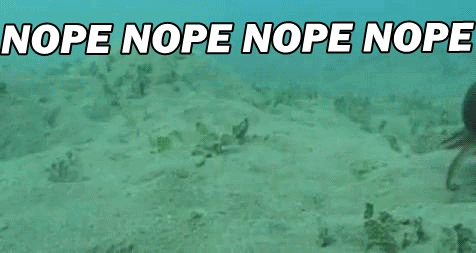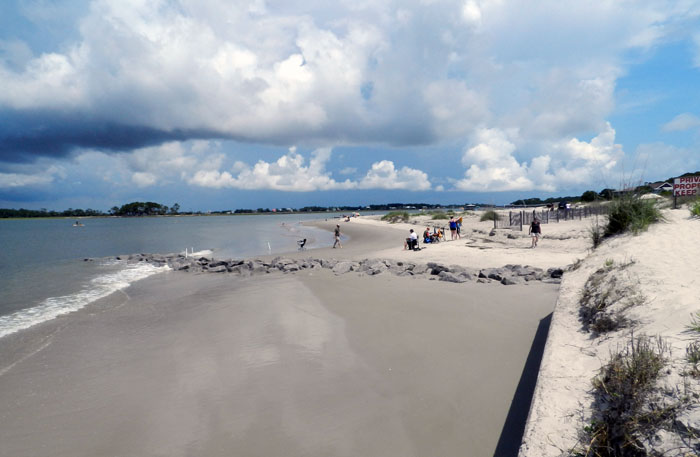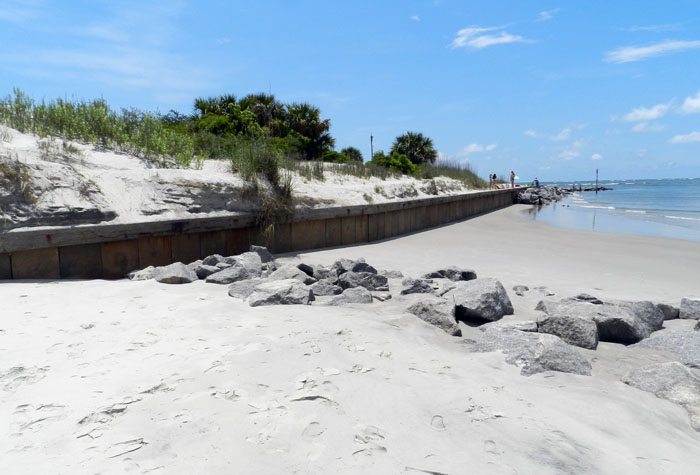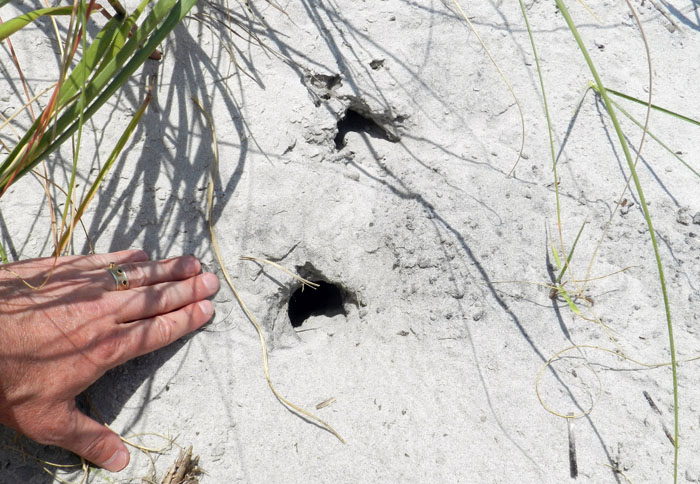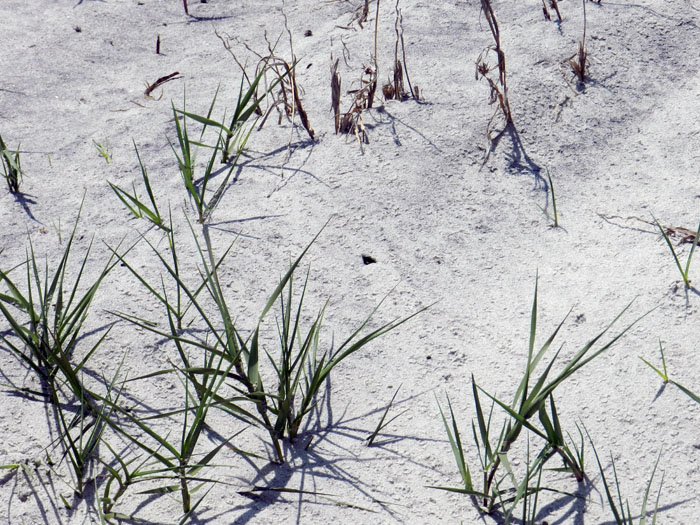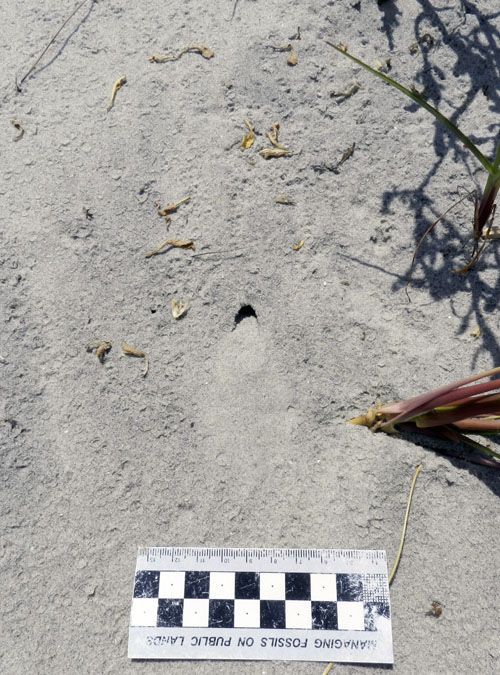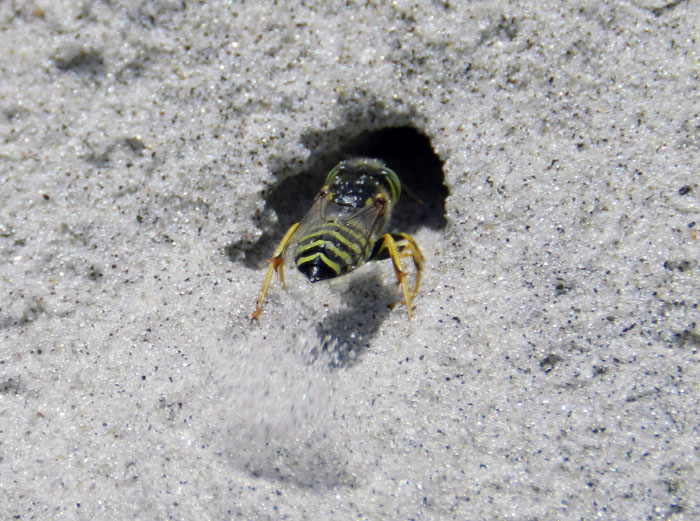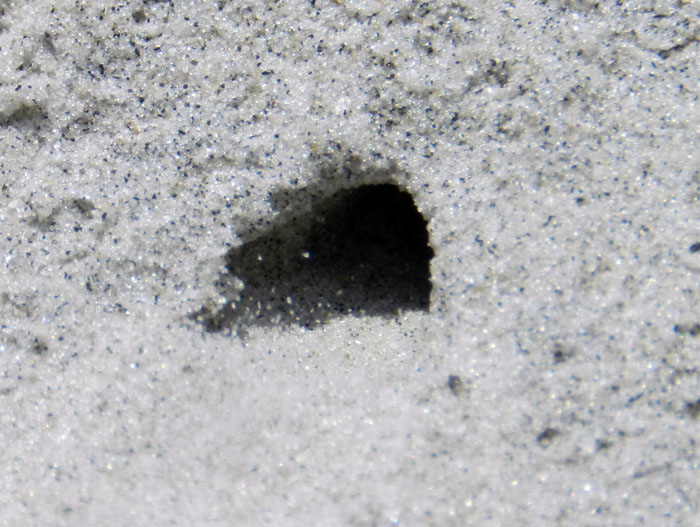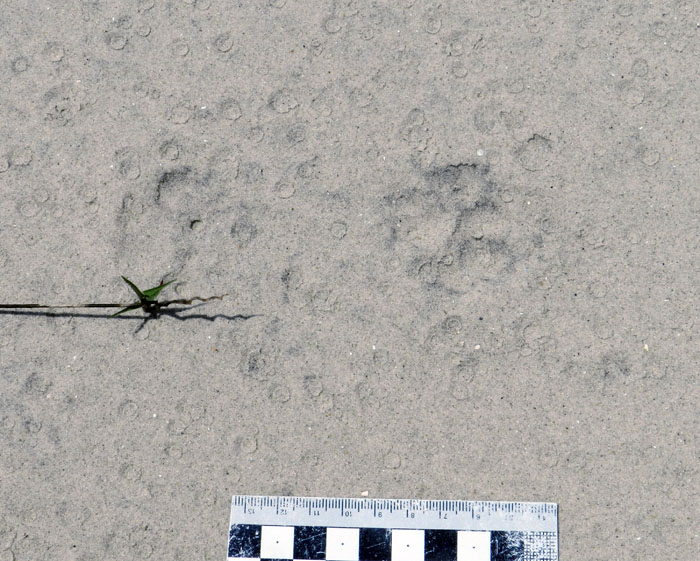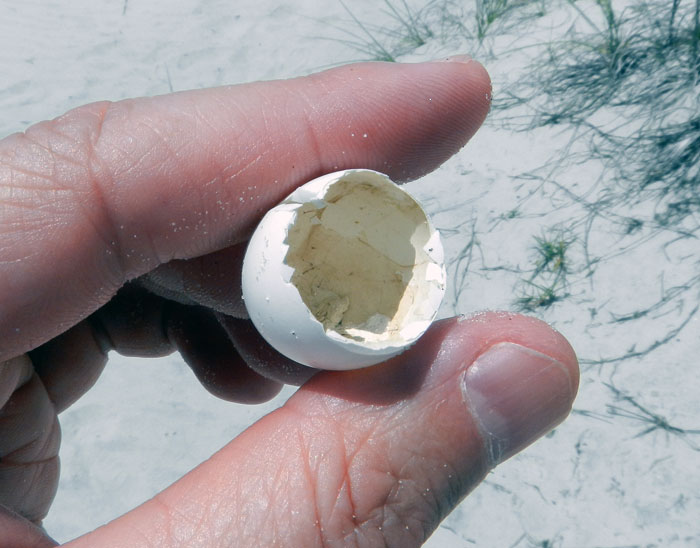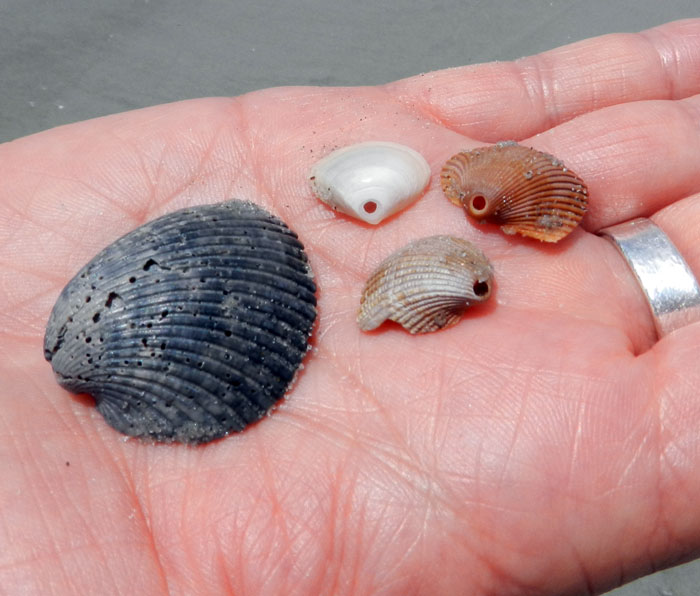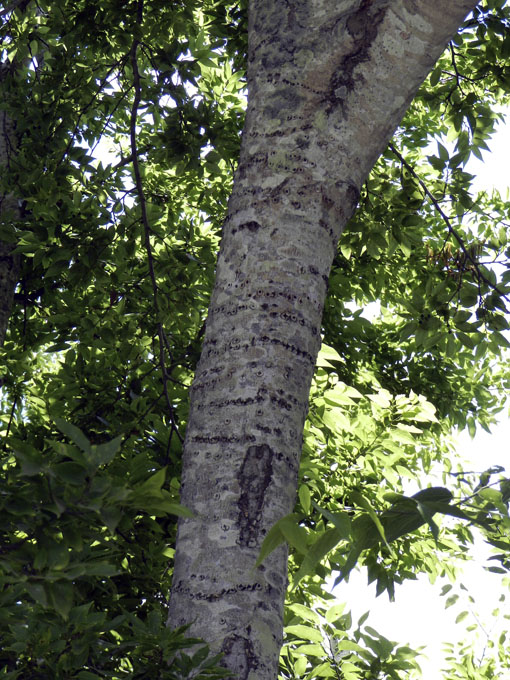Anyone who knows a little bit about dinosaurs knows that some of them made nests, took care of their young, and that their parenting skills must have been more like birds, rather than most reptiles. If pressed, most dino-enthusiasts can further say this concept is exemplified by two dinosaurs, the large ornithopod Maiasaura and the small theropod Troodon, both of which lived at the same time and place, 75 million years ago and in what we now called Montana.
But what animals lived beneath the nests and feet of those dinosaur parents and their babies? What behaviors did these animals express 75 million years ago? Would the behaviors of these animals have resembled those of ones living today, or did they reflected evolutionary dead-ends? And did these animals also take care of their young?
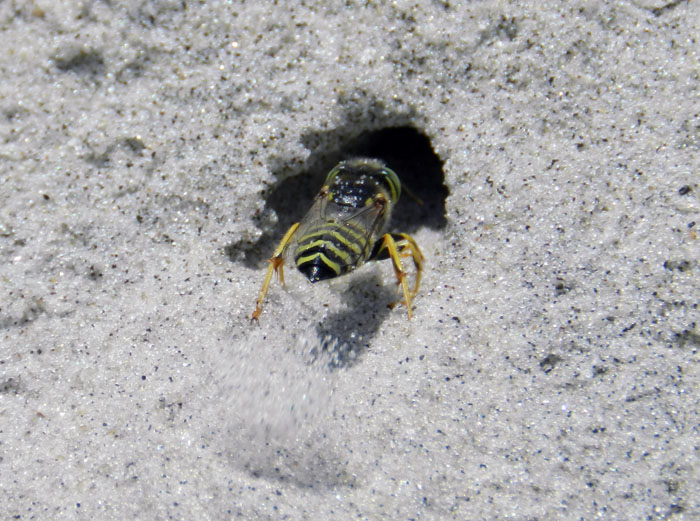 Whoa, check out this female Carolina sand wasp (Stictia carolina), energetically digging an inclined burrow into a Georgia coast dune! Why is she digging a burrow? To make a brooding chamber for her babies (larvae), who will hatch from their eggs and chow down on paralyzed prey stuffed into that chamber by their thoughtful mama. Gee, I wonder if any wasps did this in the geologic past? (Photograph by Anthony Martin, taken on Tybee Island.)
Whoa, check out this female Carolina sand wasp (Stictia carolina), energetically digging an inclined burrow into a Georgia coast dune! Why is she digging a burrow? To make a brooding chamber for her babies (larvae), who will hatch from their eggs and chow down on paralyzed prey stuffed into that chamber by their thoughtful mama. Gee, I wonder if any wasps did this in the geologic past? (Photograph by Anthony Martin, taken on Tybee Island.)
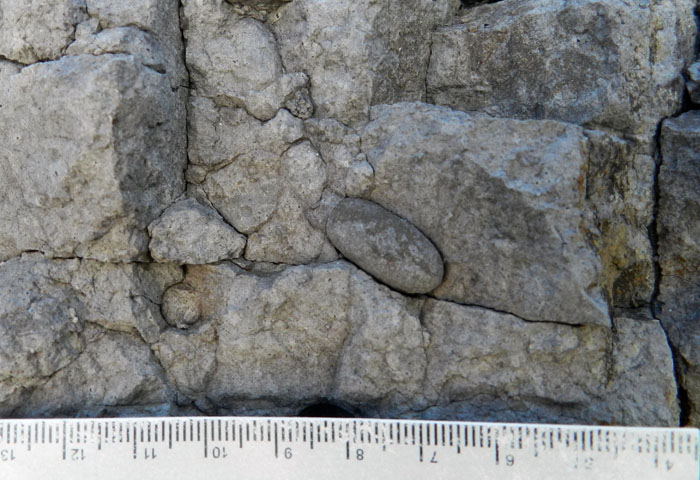 Why, yes, they did. That’s a fossil cocoon connected to an inclined burrow, reflecting a behavior much like that of modern sand wasps, but preserved in the Late Cretaceous Two Medicine Formation of central Montana. (Photograph by Anthony Martin.)
Why, yes, they did. That’s a fossil cocoon connected to an inclined burrow, reflecting a behavior much like that of modern sand wasps, but preserved in the Late Cretaceous Two Medicine Formation of central Montana. (Photograph by Anthony Martin.)
The answers to these questions are, in order: insects (wasps and beetles; most likely), burrowing and reproduction; they behaved very much like modern insects, and they likely did take care of their young by making brooding chambers and leaving food for their offspring. In my experience, these revelations surprise many people, who may not be aware of how many of the insects we live with today are descended from insects lineages that shared the same ecosystems with dinosaurs throughout the 165-million-year history of the latter animals.
This summer, for me to learn more about life underground way back then, I had to go to the same site in central Montana where our understanding of dinosaur parenting became better defined, but also where I first learned how insect parenting related to dinosaur parenting. Where I am now is the same general location where the first known dinosaurs nests in North America were found in the late 1970s by Jack Horner and his friend Bob Makela (mentioned in my previous blog post).
One of the most productive and interesting of these nest sites, which are all in the Late Cretaceous Two Medicine Formation, was informally dubbed “Egg Mountain.” The “Egg” part of the moniker is easy to understand, but the “Mountain” part is more of an exaggeration, as it’s an isolated and modest hill on the high-plains landscape of central Montana. Anyway, I’m working there now, along with a dedicated crew of rubble pickers being led by the ever-intrepid Dr. David Varricchio.
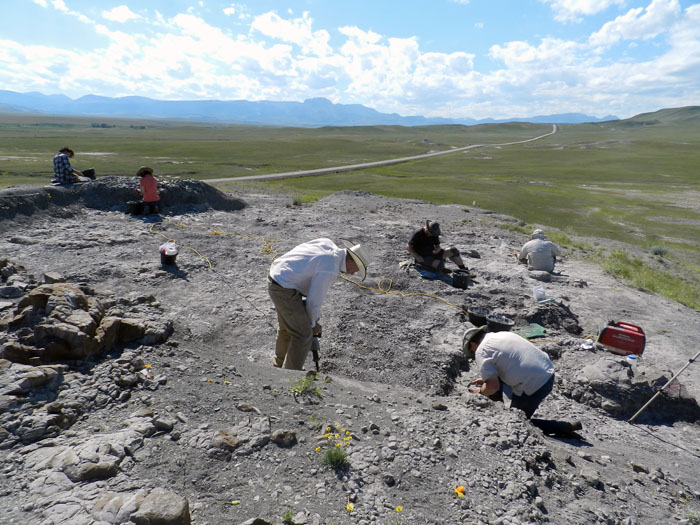 A snapshot of science in process at Egg Mountain in central Montana. Dr. David Varricchio (center, with jackhammer) has been leading an NSF-sponsored study of the fossils at this site, with the hope of understanding more about nesting dinosaurs and the animals that lived around them. Rubble pickers for scale. (Photograph by Anthony Martin.)
A snapshot of science in process at Egg Mountain in central Montana. Dr. David Varricchio (center, with jackhammer) has been leading an NSF-sponsored study of the fossils at this site, with the hope of understanding more about nesting dinosaurs and the animals that lived around them. Rubble pickers for scale. (Photograph by Anthony Martin.)
So why would an ichnologist like me care about a site that is famous for its mere body fossils, consisting of many dinosaur eggs, eggshells, and bones? I’ll start with three words: dinosaur nest structure. This is where the first known dinosaur nest structure – which is a trace fossil – was recognized. The structure was a rimmed depression about the size of a kiddie pool, but a little more shallow. In the center of this depression was a clutch of eggs belonging to the small theropod Troodon. The width of the nest was perfect for accommodating an adult Troodon, which probably sat above the egg clutch to protect and incubate it.
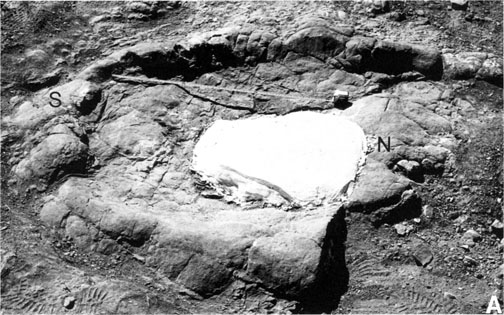 Here’s the first known dinosaur nest structure, as it looked soon after its discovery in the mid-1990s. The rim is composed of limestone, but originally was soil compacted and shaped by either one or both Troodon parents. The white part is plaster of Paris covering the egg clutch, which was aligned with the dead center (pun intended) of the structure. Tape measure shows 1 m (3.3 ft). Photograph was probably taken by David Varricchio, and is from Varricchio et al. (1999), Journal of Vertebrate Paleontology, v. 19, p. 91-100.
Here’s the first known dinosaur nest structure, as it looked soon after its discovery in the mid-1990s. The rim is composed of limestone, but originally was soil compacted and shaped by either one or both Troodon parents. The white part is plaster of Paris covering the egg clutch, which was aligned with the dead center (pun intended) of the structure. Tape measure shows 1 m (3.3 ft). Photograph was probably taken by David Varricchio, and is from Varricchio et al. (1999), Journal of Vertebrate Paleontology, v. 19, p. 91-100.
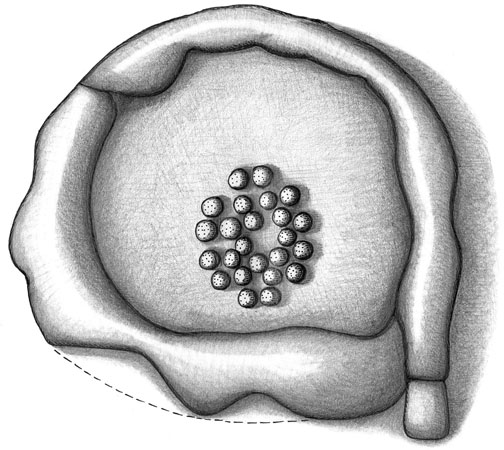 My artistic recreation of this same rimmed Troodon nest structure with its egg clutch in the middle. The inner part of the structure – inside the rim – is about a meter wide. (Artwork by Anthony Martin, from Dinosaurs Without Bones (2014), which you should buy so I can better afford to do more research like this and blog about it for you.)
My artistic recreation of this same rimmed Troodon nest structure with its egg clutch in the middle. The inner part of the structure – inside the rim – is about a meter wide. (Artwork by Anthony Martin, from Dinosaurs Without Bones (2014), which you should buy so I can better afford to do more research like this and blog about it for you.)
What’s even better about this find – ichnologically speaking – is how the parent dinosaurs must have moved the eggs after the mother laid them, and then partially buried them upright in soil. These eggs are elongate, which means they would have reclined if laid by a mother Troodon. Instead, they were nearly vertical, which means either the mother or father dinosaur manipulated these eggs after they emerged from the mother dinosaur. Thus this orientation is also a trace fossil of parental dinosaurs that were greatly increasing the chances their future offspring would stay alive.
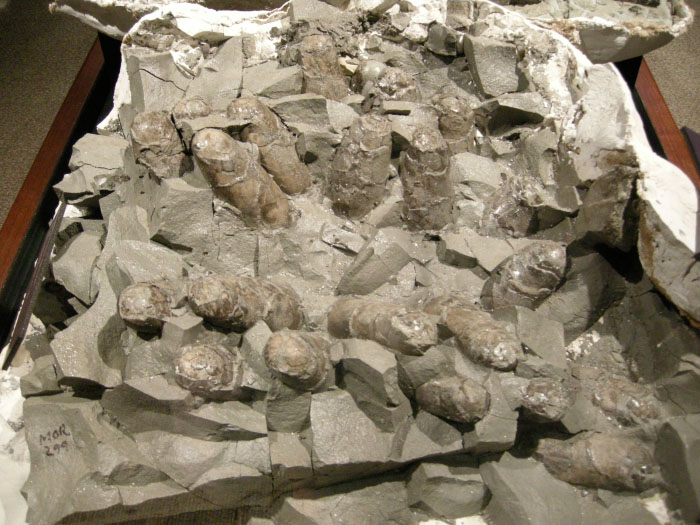 Bottom view of the Troodon egg clutch from that nest structure, with these elongate eggs in nearly vertical positions, and aligned along a central axis. These arrangements of the eggs are trace fossils, too. Want to see this clutch for yourself? It’s is on display in the Museum of the Rockies in Bozeman, Montana. (Photograph by Anthony Martin.)
Bottom view of the Troodon egg clutch from that nest structure, with these elongate eggs in nearly vertical positions, and aligned along a central axis. These arrangements of the eggs are trace fossils, too. Want to see this clutch for yourself? It’s is on display in the Museum of the Rockies in Bozeman, Montana. (Photograph by Anthony Martin.)
Now let’s leave dinosaurs for a moment and talk about something that really matters, like insect trace fossils. What is well known by those who have worked at Egg Mountain is that the dinosaurs there were not alone. Just below the dinosaurs’ nests, egg clutches, and feet were insects, and lots of them, shown by numerous cocoons. In a few places near Egg Mountain, these exquisitely preserved cocoons – most with their spiraled weave patterns still visible – are so common, you can close your eyes and scoop up a handful of them.
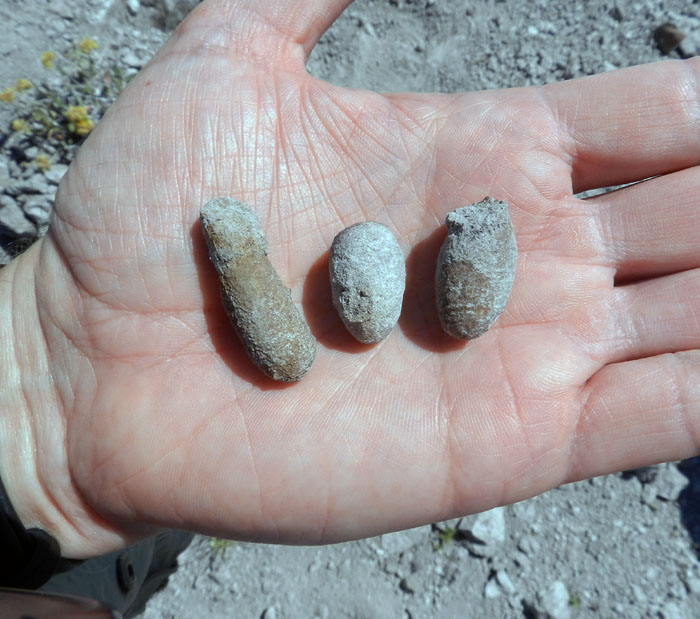 Fossil insect cocoons from the Two Medicine Formation and a locality near Egg Mountain. The cocoons on the left and right are ichnological two-for-one specials: the left one has a partial burrow attached to it, and the right one has an emergence trace (top) from where the adult insect said goodbye to its cocoon 75 million years ago. (Photograph by Anthony Martin.)
Fossil insect cocoons from the Two Medicine Formation and a locality near Egg Mountain. The cocoons on the left and right are ichnological two-for-one specials: the left one has a partial burrow attached to it, and the right one has an emergence trace (top) from where the adult insect said goodbye to its cocoon 75 million years ago. (Photograph by Anthony Martin.)
In an article I coauthored with David Varricchio in 2011, we concluded that most of these insect cocoons were likely from burrowing wasps, and the rest may have been from beetles. The trace fossils reflect a unexpectedly modern behavior in these Cretaceous wasps, which dug inclined tunnels that led down to enlarged brooding chambers. These insects laid eggs in the chambers and stocked them with provisions, which may have been paralyzed prey, such as other insects or spiders. Later, larvae hatched in the chambers, ate whatever Mother Wasp left for them, made cocoons around themselves once they decided to stop being so larval, pupated, burst out of their cocoons when they became adults, and emerged on the surface.
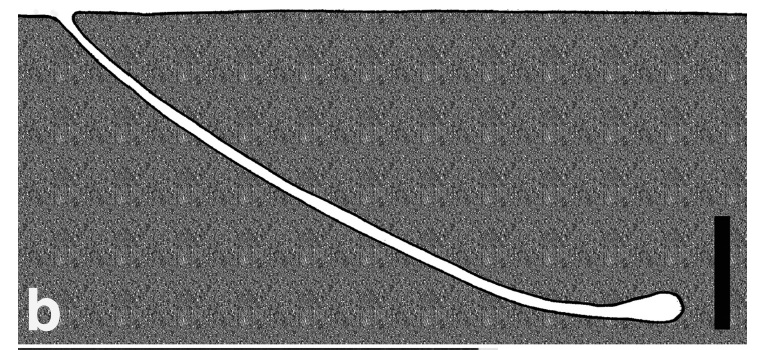 My simple depiction of a burrow and pupal chamber made by the solitary Carolina sand wasp (Stictia carolina). These traces consist of inclined tunnels that end in enlarged chambers, the latter of which accommodate eggs, food, and eventually larvae and cocoons. Scale = 10 cm (4 in). (Illustration by Anthony Martin, which is in Life Traces of the Georgia Coast (2013), which you should buy so I can better afford to do more research like this and blog about it for you.
My simple depiction of a burrow and pupal chamber made by the solitary Carolina sand wasp (Stictia carolina). These traces consist of inclined tunnels that end in enlarged chambers, the latter of which accommodate eggs, food, and eventually larvae and cocoons. Scale = 10 cm (4 in). (Illustration by Anthony Martin, which is in Life Traces of the Georgia Coast (2013), which you should buy so I can better afford to do more research like this and blog about it for you.
 Close-up of the burrow end – filled with sediment, but now rock – leading to a cocoon, still preserved in its pupal chamber in the Two Medicine Formation, from about 75 million years ago. Compare this to my illustration of a typical modern sand-wasp burrow, especially the end part of it. Notice the resemblance? (Photograph by Anthony Martin.)
Close-up of the burrow end – filled with sediment, but now rock – leading to a cocoon, still preserved in its pupal chamber in the Two Medicine Formation, from about 75 million years ago. Compare this to my illustration of a typical modern sand-wasp burrow, especially the end part of it. Notice the resemblance? (Photograph by Anthony Martin.)
However, most of the fossil cocoons in the Two Medicine Formation did not make it past the pupal stage. How do we know this? Because some of these outcrops have thousands of cocoons that are perfectly preserved as beautiful ellipsoids, with no sign that an adult insect emerged from them. One of the axioms of paleontology is that each animal’s tragedy of the past can some day fulfill a paleontologist’s dreams. Thus these thousands of dead Cretaceous wasps are providing me with much joy this summer, as I study these trace fossils for more clues about their lives and how they related to the ecosystems they shared with adult and baby dinosaurs.
 A picture of one happy ichnologist, who is giving thanks for all of those insects that died and had their burrows and cocoons fossilized in the Two Medicine Formation for him to study. Thanks, insects! Thanks, geology! (Photograph taken by Ruth Schowalter in central Montana.)
A picture of one happy ichnologist, who is giving thanks for all of those insects that died and had their burrows and cocoons fossilized in the Two Medicine Formation for him to study. Thanks, insects! Thanks, geology! (Photograph taken by Ruth Schowalter in central Montana.)
But here’s what really cool about Egg Mountain: it has both dinosaur nests and insect nests, implying that wherever these insects nested, so did the dinosaurs. As a result, their co-occurrence gives us a glimpse of the ecology of those places at that time, a window into the past landscapes in which they lived and bred. This makes sense when you imagine how both these dinosaurs and insects wanted to keep their eggs out of water, so they placed them in high-and-dry areas, such as well-drained soils well above the water table. So as we gather more information from this site, we get ever-better insights in the cycles of life for both Cretaceous insects and the dinosaurs that happened to live in their world.


